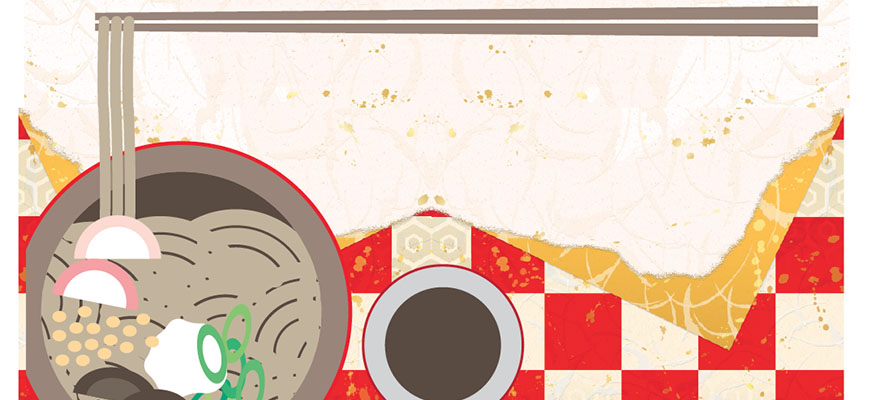Home > Highlighting JAPAN >Highlighting Japan December 2013>Japan's technological achievements
Highlighting JAPAN
Student's Corner
Toshikoshi

Do you have any end-of-year special traditions? For some people, New Year's Eve means a party with friends and fancy clothes. In Japan, there are a few different ways to say goodbye to the old year. New Year's Eve is a quiet time to spend at home with family and perhaps visit a local temple.
The traditional meal on New Year's Eve varies but is often concluded with a hot bowl of noodles called toshikoshi soba, which means, year-end buckwheat noodles. Why buckwheat noodles? There are a few explanations that are given about its significance.
One is that the buckwheat plant is especially strong. Even in bad weather, it bounces back. So by eating it, perhaps we too can be strong and resilient. Another is that the noodles are long and thin, and eating them symbolizes a long life. And yet there is also a reason that goldsmiths used to use buckwheat flour dough to pick up loose gold dust around their smithing shops. So by eating these noodles, people hope that good fortune also sticks to them. Strength, long life, good fortune: great things to wish for.
After eating the warming and lucky noodles, it's time to gather up last year's protection amulets and good luck charms to do misokapparai, or year-end purification. In this ritual, a special stick is festooned with paper streamers and waved around all corners of the house to banish any evil spirits that may be lurking. Be gone, evil spirits! It is then planted in the ground outside to guard the home.
Now it's time to head to the temple. In the last hours of the year, there is a ceremony called joya no kane, or New Year's Eve bells. In this ritual, the temple bell is rung 108 times, each chime representing an earthly temptation fading away.
Visitors can help with the ringing of the bell, and it usually takes a few hours, with 107 chimes during the old year and the final chime at the beginning of the New Year. Lots of neighborhood people join in and help to send the old year out with a gong of the bell.
While the bell ceremony is taking place, you can bring your temple omamori, or good luck charms and protection amulets, that you might have gotten during the year, to the temple's burning place called otakiagejyo. The charms are burned in a special fire, and thanks are offered to the charms for their protection over the past year.
So if you spend your New Year's Eve in Japan, you may find yourself in the cold winter dark approaching midnight, with your belly full of noodles and your ears full of the solemn sound of the temple bell. Listen to the worldly cares of the last year melt away with each bell toll, and watch the events of the last year curl up on wisps of smoke and fly away as the sacred good luck charms take to the air. Reflect on the last year and get ready to say farewell. A fresh and clean new year is starting.
Recipe
Simple toshikoshi soba / Serves 2
6 ounces of soba noodles
2 cups of dashi - Japanese broth made from fish, seaweed or mushrooms
1 tablespoon sake for cooking
1 tablespoon soy sauce
¾ teaspoon sugar
A few green onions, sliced into small pieces
Red pepper flakes
Optional toppings:
Sliced fish cake, an egg or sliced vegetables like mushrooms, carrots or leeks
Cook and rinse the noodles according to the package instructions. In a small saucepan, mix together the dashi, sake, soy sauce, and sugar, and bring to a boil, then turn to low heat. Put the noodles in the soup and heat on low for 1-2 minutes, then divide into bowls and sprinkle green onions and chili pepper on top with extra toppings as desired.
Glossary
年越しそば (toshikoshi soba) year-end soba
仏壇 (butsudan) Buddhist family altar, where you pray to your ancestors
晦日祓い (misokapparai) year-end purification ceremony
除夜の鐘 (joya no kane) New Year's Eve bells
お守り(omamori) protective good luck charms from temples or shrines
お焚き上げ所 (otakiagejyo) a special burning place for good luck charms used in the past year
© 2009 Cabinet Office, Government of Japan






